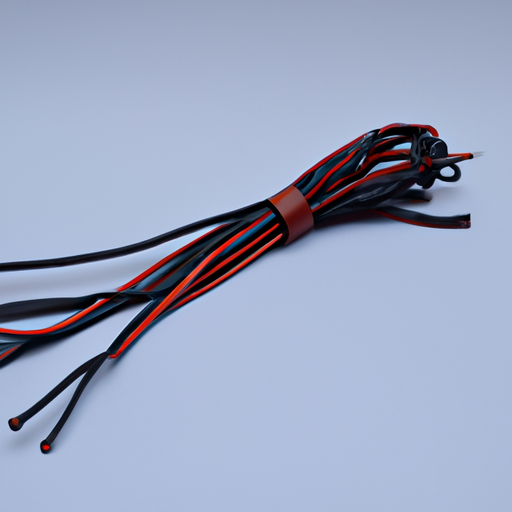

Title: Understanding Cable Components: A Comprehensive Guide

1. Conductors (200 words) At the core of every cable lies the conductor, which carries the electrical current. Conductors are typically made of copper or aluminum due to their excellent conductivity properties. Copper is the preferred choice for most applications due to its superior conductivity and resistance to corrosion. Aluminum conductors are commonly used in power transmission cables due to their lightweight nature. The size and number of conductors within a cable depend on the intended application and the amount of current it needs to carry.
2. Insulation (250 words) Surrounding the conductor is the insulation, which serves to protect the conductor from external factors and prevent electrical leakage. Insulation materials are carefully selected based on their dielectric properties, mechanical strength, and resistance to environmental conditions. Common insulation materials include polyvinyl chloride (PVC), polyethylene (PE), and cross-linked polyethylene (XLPE). PVC is widely used due to its cost-effectiveness and versatility, while PE and XLPE offer enhanced durability and resistance to higher temperatures.
3. Shielding (250 words) Shielding is an essential component in cables used for data transmission, as it protects against electromagnetic interference (EMI) and radio frequency interference (RFI). Shielding can be achieved through various methods, including braided shields, foil shields, or a combination of both. Braided shields, made of copper or aluminum, provide excellent flexibility and coverage, while foil shields offer better protection against high-frequency interference. The choice of shielding depends on the specific application and the level of interference expected.
4. Jacketing (200 words) The outermost layer of a cable is the jacket, which provides mechanical protection and insulation against external elements. Jackets are typically made of materials such as PVC, polyurethane (PU), or thermoplastic elastomers (TPE). PVC jackets are commonly used due to their cost-effectiveness and resistance to abrasion, moisture, and chemicals. PU and TPE jackets offer enhanced flexibility, durability, and resistance to extreme temperatures, making them suitable for harsh environments.
5. Connectors (200 words) Connectors are the interface between cables and devices, allowing for easy and secure connections. They come in various types, including USB, HDMI, Ethernet, and coaxial connectors, each designed for specific applications. Connectors are typically made of metal, such as copper or gold-plated brass, to ensure reliable electrical contact and durability. The choice of connector depends on the intended use, data transfer requirements, and compatibility with the devices being connected.
Conclusion (100 words) Understanding the components that make up a cable is crucial for selecting the right cable for any given application. Conductors, insulation, shielding, jacketing, and connectors all play vital roles in ensuring efficient and reliable data and power transmission. By considering the specific requirements of your application and the properties of each component, you can make informed decisions when choosing cables. Whether it's for home electronics, industrial machinery, or telecommunications, a thorough understanding of cable components empowers you to make the right connections.
Title: Understanding Cable Components: A Comprehensive Guide

1. Conductors (200 words) At the core of every cable lies the conductor, which carries the electrical current. Conductors are typically made of copper or aluminum due to their excellent conductivity properties. Copper is the preferred choice for most applications due to its superior conductivity and resistance to corrosion. Aluminum conductors are commonly used in power transmission cables due to their lightweight nature. The size and number of conductors within a cable depend on the intended application and the amount of current it needs to carry.
2. Insulation (250 words) Surrounding the conductor is the insulation, which serves to protect the conductor from external factors and prevent electrical leakage. Insulation materials are carefully selected based on their dielectric properties, mechanical strength, and resistance to environmental conditions. Common insulation materials include polyvinyl chloride (PVC), polyethylene (PE), and cross-linked polyethylene (XLPE). PVC is widely used due to its cost-effectiveness and versatility, while PE and XLPE offer enhanced durability and resistance to higher temperatures.
3. Shielding (250 words) Shielding is an essential component in cables used for data transmission, as it protects against electromagnetic interference (EMI) and radio frequency interference (RFI). Shielding can be achieved through various methods, including braided shields, foil shields, or a combination of both. Braided shields, made of copper or aluminum, provide excellent flexibility and coverage, while foil shields offer better protection against high-frequency interference. The choice of shielding depends on the specific application and the level of interference expected.
4. Jacketing (200 words) The outermost layer of a cable is the jacket, which provides mechanical protection and insulation against external elements. Jackets are typically made of materials such as PVC, polyurethane (PU), or thermoplastic elastomers (TPE). PVC jackets are commonly used due to their cost-effectiveness and resistance to abrasion, moisture, and chemicals. PU and TPE jackets offer enhanced flexibility, durability, and resistance to extreme temperatures, making them suitable for harsh environments.
5. Connectors (200 words) Connectors are the interface between cables and devices, allowing for easy and secure connections. They come in various types, including USB, HDMI, Ethernet, and coaxial connectors, each designed for specific applications. Connectors are typically made of metal, such as copper or gold-plated brass, to ensure reliable electrical contact and durability. The choice of connector depends on the intended use, data transfer requirements, and compatibility with the devices being connected.
Conclusion (100 words) Understanding the components that make up a cable is crucial for selecting the right cable for any given application. Conductors, insulation, shielding, jacketing, and connectors all play vital roles in ensuring efficient and reliable data and power transmission. By considering the specific requirements of your application and the properties of each component, you can make informed decisions when choosing cables. Whether it's for home electronics, industrial machinery, or telecommunications, a thorough understanding of cable components empowers you to make the right connections.